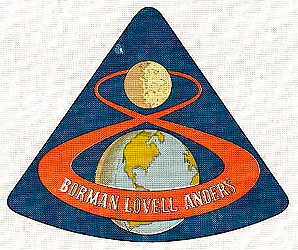
|
|

| Crew & Mission |
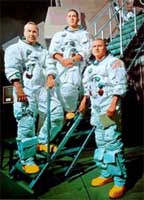 (S68-50265, 22 November, 1968) - Apollo 8 crew is photographed posing on a Kennedy Space Center (KSC) simulator in their space suits.
(S68-50265, 22 November, 1968) - Apollo 8 crew is photographed posing on a Kennedy Space Center (KSC) simulator in their space suits. As soon as Borman's crew learned, on 10 August, 1968 that it might fly a lunar mission, the men began to train for the moon flight. On 9 September, sessions on the Cape simulator began. With the help of the support team - Mattingly, Carr, and Brand the crew was ready on time. Shortly after 2:30 on the morning of 21 December, Borman, Lovell, and Anders rose and dressed for the launch day breakfast for Apollo's second manned flight. Riding the huge Saturn-V AS-503 with CSM 103, propelled by more power than man had ever felt pushing him before (33.4 million newtons, or 7.5 million pounds of thrust), the crew had varied impressions. Borman thought it was a lot like riding the Gemini Titan II. Lovell agreed but added that it seemed to slow down after it left the pad. Rookie astronaut Anders likened it to "an old freight train going down a bad track." A dozen minutes after launch, the S-IVB third stage had already fired to drive itself and the spacecraft into earth-orbital flight. Borman, Lovell, Anders checked the spacecraft in preparation for the next step in the mission. At 10:17, former crew member Collins at the capcom's console opened a new era in space flight when he said, "All right, you are go for TLI [translunar injection]." After succesfully entering the Moon's orbit the crew members told their fellow men what the moon looked like at this close range. Lovell said: "Okay, Houston, The moon is essentially gray, no color; looks like plaster of Paris or sort of a grayish deep sand. We can see quite a bit of detail. The Sea of Fertility doesn't stand out as well here as it does back on earth. There's not as much contrast between that and the surrounding craters. The craters are all rounded off. There's quite a few of them; some of them are newer. Many of them . . . - especially the round ones - look like hits by meteorites or projectiles of some sort." The trip back to the earth was uneventful. Now the space-weary travelers could rest, eat, sleep, show television, and enjoy the ride home. Early Saturday morning, 14,500 kilometers above the earth, the crew fired the pyrotechnics to separate the command module from the service module, which had worked perfectly whenever it was needed. Fifteen minutes later, the spacecraft crossed into the fringes of the atmosphere, 120 kilometers above the earth. Borman told Mattingly they had a real fireball but were in good shape. Spacecraft speed increased to 9,700 meters per second, subjecting the crew to a load of nearly seven g. The craft came down in darkness on Friday, 27 December (6 days, 3 hours, and 42 seconds after launch), flipping over on its nose as it landed. Until Borman punched the button that inflated the air bags to upright the spacecraft, its flashing light beacon was lost to the sight of the recovery helicopters. Mission ground rules required a daylight recovery, so Borman and his crew waited 45 minutes for the swimmers to open the hatches. A few minutes later, the helicopter deposited the crew on the deck of the U.S.S. Yorktown for the last lap of - in Borman's words - "a most fantastic voyage."
|
| A Personal Story |
|
"The design of the Apollo-8 patch was quite unique. Borman and I were in California working on our Apollo spacecraft when we got the word that our mission had been changed. We were going to take McDivitt's spacecraft and make a circumlunar flight around the moon.
On the way back to Houston the next evening, Frank was flying the airplane, and since I had nothing to do I sort of sketched out what I thought would be an appropriare patch. The shape of the patch symbolizes the Apollo spacecraft. The figure 8 signifies Apollo-8 and also the flight path we took to the moon and back. After I returned to Houston I gave my sketches to the NASA artist who made the final drawing.
|
| The Artwork |
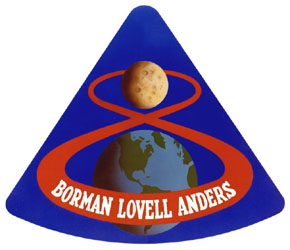 December 01, 1968 -- NASA photo ID: S68-51093. Apollo 8 insignia Description: Insignia for Apollo 8 lunar orbit mission.
|
| The Real Thing |
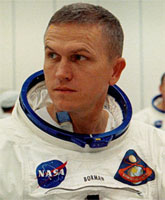
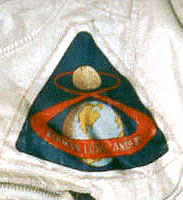
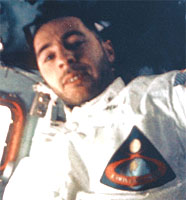
Left: Frank Borman wearing the beta-cloth patch on launchday. Center: The patch on the pressure suits was cut to shape. Right: Astronaut William Anders during intravehicular activity. He is wearing the beta-cloth version of the patch. 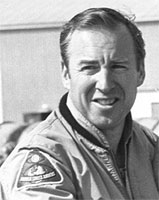
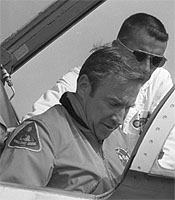
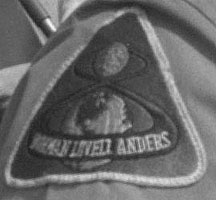
|
| Variations |
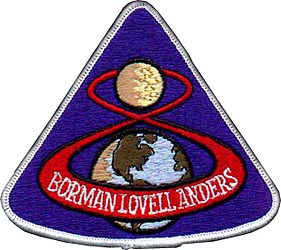 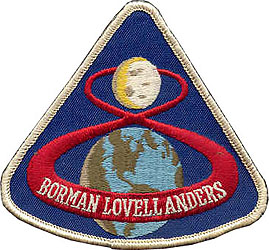 Left: The AB Emblem version. Right: Lion Brothers version. |
| Related and Souvenir |
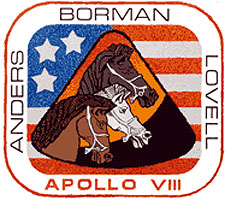 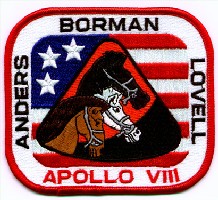
This design for the Apollo-8 emblem was probably never consderd by the astronauts to be a real crew-emblem, because the mission was changed from earth-orbital flight to a lunar mission in August 1968. Faint lines can be seen around the name Apollo-8, suggesting that it was placed over another one, probably Apollo-9. In the orginal mission sequence, Apollo-8 would be flown with astronauts McDivitt, Scott and Schweicart to test the lunar module in earth orbit in the fall of 1968. That would be followed in early 1969 by Apollo-9, manned by Borman, Collins and Anders, who would repeat these test in high earth orbit. In July 1968 Apollo-9 CMP Mike Collins had to undergo surgery and was replaced by his backup Jim Lovell. Then on August 11, 1968 the decision was made to switch the two missions because of delays in delivering the first LM. Borman, Lovel and Anders thus became the Apollo-8 crew and the LM test flight was bumped to Apollo-9. Jim Lovell did not recognise this emblem when it was shown to him, but he did state that he made the first sketch for the eventual Apollo-8 emblem in the backseat of a T-38, flown by his commander Frank Borman from LA to Houston on August 12, 1968, the day after they had heard they would go to the moon. He says that his sketch so accurately reflected the mission that no other designs were ever considered. It is thus likely that the early designed emblem was designed for Apollo-9 after Lovell was added to that crew, but before that mission was switched with Apollo-8. The "texture" in the US flag suggests that it was drawn by the same anonymous NASA-artist who made the Apollo-1 and Apollo-7 emblems. The three stars in the flag represent the three Apollo astronauts, while the nine red and white bars may stand for Apollo-9. After the switch the name in the design was changed to Apollo-8, but it was never reviewed by the crew because by now Lovell had made his own design. It is interesting that the final design of the Apollo-8 emblem has the triangular shape of an Apollo command module, wich can also be seen in this early version. The three horses can also be found in the emblem of Lovell's next flight, Apollo-13. That emblem was designed by artist Lumen Winter.
|